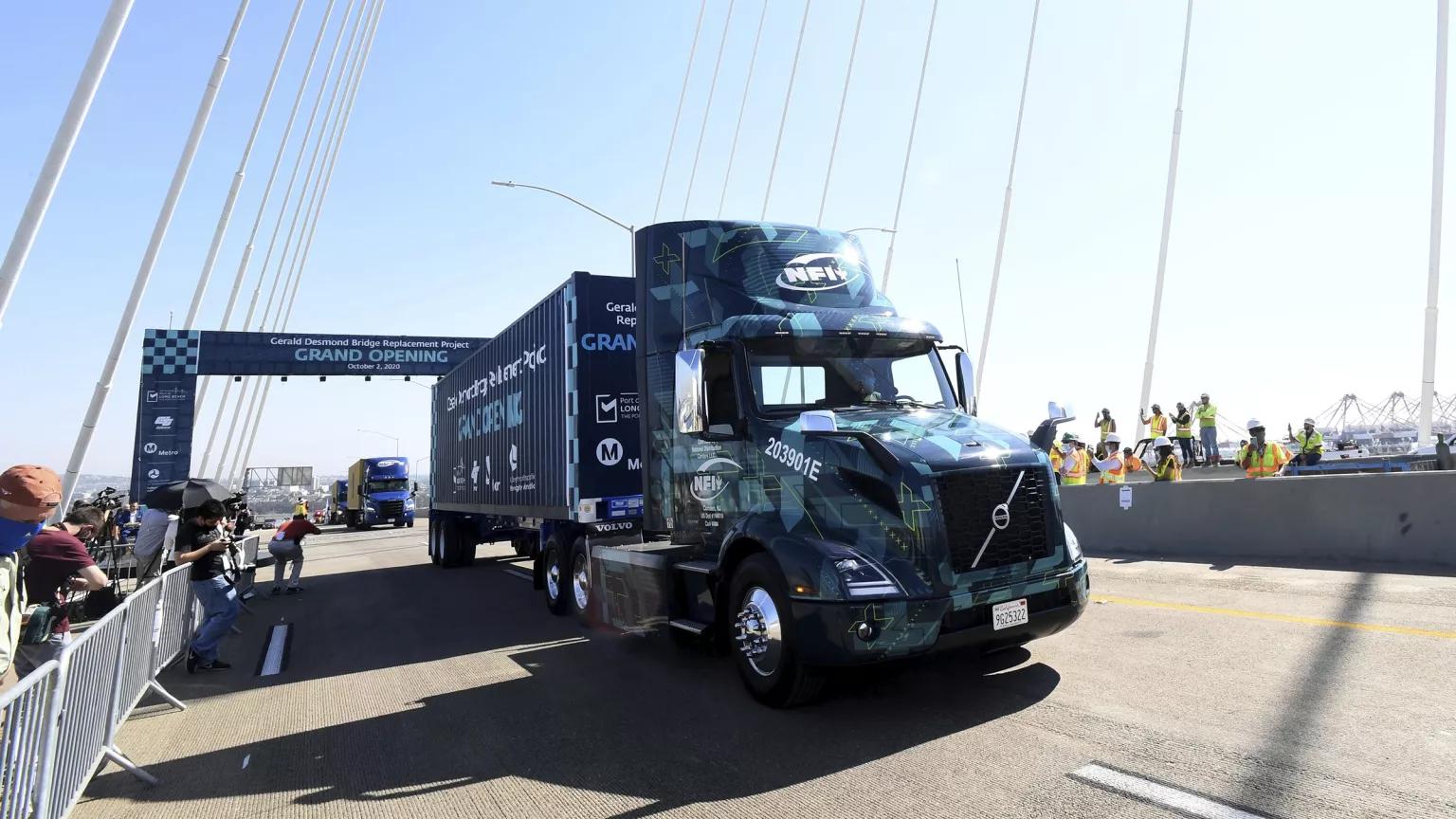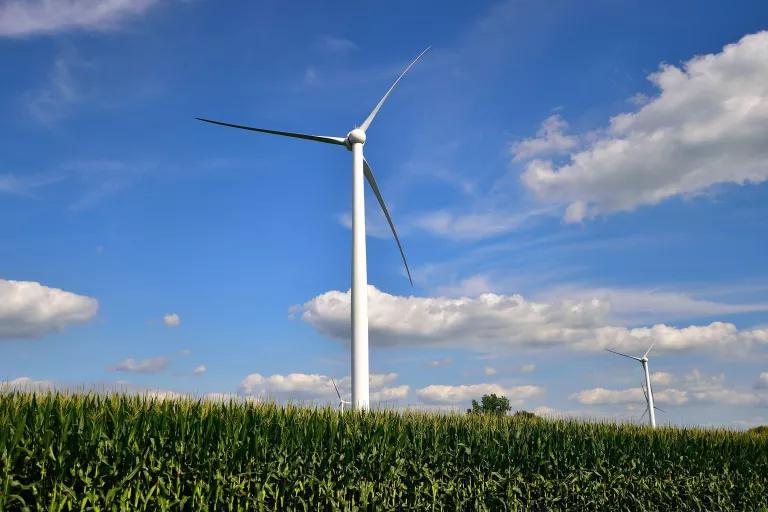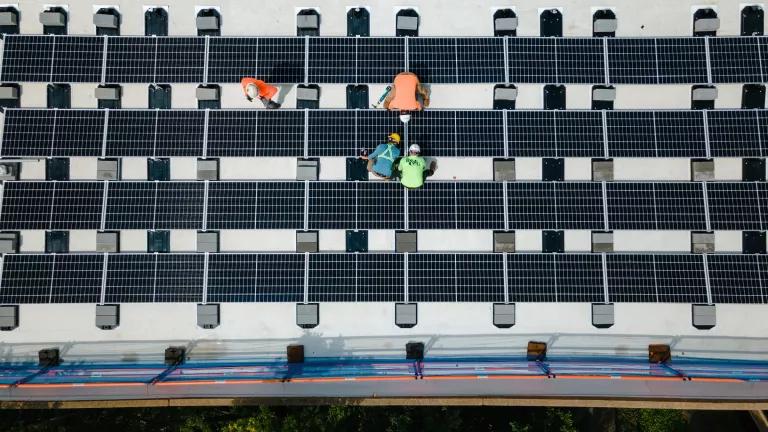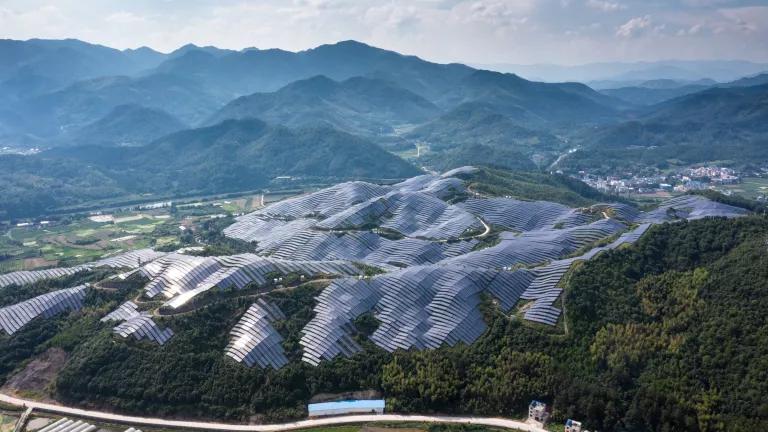Advancing Clean Buildings and Transportation
From energy efficiency to electric vehicles, NRDC is transforming the places where we live and work and how we get around.

Brittany Murray/The Orange County Register via AP Photo
NRDC knows that climate solutions start in our communities. That’s why we’re working to advance clean building and transportation initiatives across the country—from retrofitting affordable housing in the Midwest to expanding fleets of zero-emission trucks in California. Transforming the transportation and building sectors won’t just curb the pollution driving climate change. It will also help create healthier and more resilient communities, as well as good-paying jobs. Together, these changes act as a potent climate solution while improving lives, here and now.

Wind turbines on a farm in Creston, Illinois
Bruce Leighty/Alamy
Illinois Takes the Lead on Clean Energy
In September, Illinois signed into law the Climate and Equitable Jobs Act (CEJA)—one of the country’s most ambitious pieces of climate legislation, with an unprecedented focus on equity and workers. It was the result of years of on-the-ground advocacy by both NRDC and our grassroots partner groups, and it put Illinois squarely on the map as a climate leader, not only in the Midwest—where it became the first state in the region to mandate a complete phaseout of fossil fuels for power generation—but in the nation.
CEJA invests in programs that make buildings more energy efficient, healthier, and cheaper to heat and cool. The law is particularly geared toward uplifting low-income communities where families pay a greater proportion of their income on utility bills. Its provisions are expected to save residents hundreds of millions of dollars on their energy costs each year, which is crucial progress in a state where more than 600,000 households live below the federal poverty level and spend anywhere between 15 and 28 percent of their income on energy. It also ensures that the growing energy efficiency industry brings jobs and opportunities to communities that have long been shut out of the clean energy economy, such as communities of color, as well as to workers who will be impacted by the shift away from fossil fuels. “We need to make sure that we’re centering the needs and interests of the most impacted communities in our transition to a clean energy economy,” said J.C. Kibbey, NRDC’s Illinois clean energy advocate. “We’re also trying to make right, as much as we can, all of the negative impacts people have suffered.”
"The youth climate movements fought for years to pass CEJA, and it finally happened. And it's only the beginning. When you put in the work and you're in for the long haul, amazing things can and will happen.”
Adelina Avalos, Chicago student activist
The new law does all of that alongside a suite of ambitious clean energy initiatives—like growing the state’s renewable energy generation fivefold and building out a network of job training hubs for workers entering fields ranging from solar panel installation to weatherization to electric vehicle (EV) manufacturing. NRDC advocates were integral in shaping CEJA, allowing a strong final bill to receive sweeping bipartisan support in the legislature and backing from a wide coalition of environmental justice and labor groups, as well as student activists. Kibbey hopes that its implementation will now propel the state’s recovery in the wake of the pandemic. “We can make our recovery an equitable, sustainable one, and position Illinois as a national leader on clean energy,” he says. “We can stop our energy systems from sickening and excluding people of color. We can bring good-paying clean energy jobs to Illinois while preserving a livable planet.”
Fighting Inequity with Solar
A program out of Minneapolis is helping to tackle multiple problems in tandem: improving access to clean energy and energy efficiency, while making housing more affordable. The city’s 4d Affordable Housing Incentive Program—supported in part by the Bloomberg Philanthropies’ American Cities Climate Challenge (ACCC), of which NRDC is a partner—offers tax incentives to landlords who set aside rent-controlled units. The measure aims to counter the housing shortage and increasingly steep rents that Minneapolis residents have seen over the last decade.
But the 4d program goes a step further: It also offers landlords rebates for installing solar panels and making energy efficiency improvements on their buildings, prioritizing environmental justice communities. In addition to curbing emissions, these efforts drive down energy bills for low-income utility customers while making homes more comfortable to live in by doing things like insulating drafty windows or swapping in efficient electric heat pumps for those run on fossil fuels. It’s also reimbursing owners of those buildings for the solar power they generate, which helps to keep the upgraded apartments within financial reach for a larger number of city residents—and staves off climate gentrification. “At a local level where we’re focused, those solutions can also be an antidote to inequity,” says Patrick Hanlon, Minneapolis’s director of environmental programs.
Did You Know?
Energy efficiency is currently the largest clean energy job creator in the United States, employing nearly three times as many workers as the fossil fuel extraction industry.
The effort is an example of NRDC’s Midwest climate leadership in action. Two states over, Derrell Slaughter—an NRDC clean energy advocate based out of Lansing, Michigan—is proud to be a part of the movement. Slaughter serves as a member of Governor Gretchen Whitmer’s newly established Council on Climate Solutions. “In every single sector and in every single meeting, we talk about equity and environmental justice,” Slaughter says. “At NRDC, my goal is to be a voice for those people from the outside.”
The Clean Car Boom
Transportation remains the single-largest contributor of U.S. carbon emissions and a significant driver of the dirty air pollution that harms our health. That’s why we’re honing in on reforming this sector and applauding the progress we’re seeing on both the federal and state levels. In December, in response to President Biden’s day-one directive to strengthen vehicle standards gutted by the Trump administration, the U.S. Environmental Protection Agency issued a set of rules that significantly tighten greenhouse gas emissions levels for new cars, SUVs, and pickup trucks in model years 2023 through 2026. The new vehicles will be cleaner due to advanced, fuel-efficient engines and high-speed transmissions or electric power trains. Not only will these standards cut carbon emissions by 3.1 billion metric tons by 2050—equivalent to two full years of emissions from all transportation in the United States—but they will also save consumers money at the pump; in turn, lower fuel costs will offset the cost of the clean vehicle technologies. Meanwhile, on the local level, NRDC is helping to build momentum for the electric vehicle revolution through investments in everything from electric truck and bus infrastructure to enhanced consumer access to clean cars.
- In California, NRDC is working to pass an ambitious Advanced Clean Fleets rule that would require truck fleets to purchase zero-emission trucks and set a 100 percent zero-emission truck sales requirement. Advocates believe these measures will go far toward protecting the health of those behind the wheel as well as communities located near ports, commercial areas, and in high-traffic corridors.
- With the help of NRDC advocacy, New York Governor Kathy Hochul signed into law new state goals requiring all new passenger vehicle sales to be zero-emissions by 2035, followed by all new commercial truck sales by 2045. NRDC urged the governor to take the first step toward achieving these targets by adopting an NYC Clean Trucks Program, based on California's Advanced Clean Trucks rule. Next up: tightening emissions standards for all fossil fuel trucks and increasing utility support for electric truck and bus infrastructure.
- With guidance from NRDC, New Jersey, Oregon, and Washington also formally adopted California’s Advanced Clean Trucks and Heavy-Duty Engine and Vehicle Omnibus rules requiring manufacturers to sell an increasing percentage of zero-emission commercial trucks and reduce air pollution by as much as 90 percent from new diesel trucks. Colorado, Connecticut, Maine, Massachusetts, and Vermont plan to finalize their own versions of the rule in 2022.
- Minnesota and Nevada became the 15th and 16th states in the nation to adopt a Clean Cars program this fall, with Washington and Virginia next in line to finalize their rules in December. Propelled by on-the-ground NRDC advocacy, the four states passed a suite of policies that will help improve consumer access to electric vehicles while reducing emissions, air pollution, and consumer expenses.
- Colorado is busy readying its clean car infrastructure investments. The Colorado Public Utilities Commission approved a $110 million plan to install approximately 20,000 electric vehicle charging stations across the state on residential, commercial, and public sites. NRDC was part of a diverse group of stakeholders who supported the proposal through the commission’s public review process. In addition, nearly 2,000 of our Colorado members submitted public comments in support of a strong Greenhouse Gas Pollution Reduction Planning Standard, which the Colorado Department of Transportation (CDOT) voted to approve in December 2021. With this standard in place, CDOT and local transportation planning organizations will be required—for the first time—to consider the climate impacts of transportation projects such as highway expansions and public transit improvements.
- Through ACCC, NRDC has supported the adoption of 10 city policies to accelerate electric vehicle programs, including electrifying municipal fleets and public transit, expanding public EV charging, and advancing residential charging requirements. NRDC also launched the Delivering Zero Emissions Communities program in partnership with the cities of Chicago, San Diego, and San José, California, to help them achieve 100 percent zero-emission commercial vehicles by 2030.
More Highlights from 2021

Building a Healthier Food System

Championing Conservation as Climate Action


Protecting Public Health

Advancing Global Climate Solutions
Time to Go Big
Check out the rest of our annual report for an overview of what we've accomplished in 2021.



